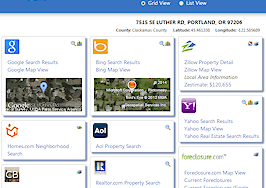FindTheBest, a “research engine” that claims 20 million monthly unique visitors, has launched neighborhood and listing search tools built around rich neighborhood data, marking the latest effort to stitch granular community information into the online real estate search experience.
“Every home has a story and today’s real estate search solutions are only able to tell a fraction of it,” said Kevin O’Connor, CEO of FindTheBest and founder of Google’s DoubleClick. “We’re aiming to connect the dots and give researchers all the information they should know not just about their house, but the surrounding context that makes that house a home.”
FindTheBest Homes, which is now accessible on findthebest.com, will provide data on 105 million properties, including 1 million for-sale homes sourced from ListHub, a listing syndicator owned by realtor.com operator Move.
The product’s differentiator, however, won’t be its property data, but the hyperlocal information that the firm mixes with that data, said Alex Rosenberg, senior director of new products at FindTheBest.
“The local attributes — schools, neighborhoods, market trends — that stuff is equally if not more important than the houses’ attributes in our view,” Rosenberg said. “We put that front and center on the page.”
In addition to displaying listing and public property data, FindTheBest Homes will also show a wide array of granular neighborhood and market data on its real estate listing pages, and will allow users to directly compare listings and neighborhoods.
That data includes school ratings, price trends, weather forecasts, homeownership rates and demographic breakdowns by education, income and age. In some cases, the site displays such data for areas that contain only a few hundred people.
Screen shot showing a FindTheBest listing page that displays demographic information for the listing’s neighborhood of Rowayton in Norwalk, Conn.
FindTheBest Homes neighborhood-search tool, which complements the product’s listing-search tool, offers even more colorful snapshots of communities, adding neighborhood data including demographic breakdowns by ethnicity, languages spoken and commuter types to data that FindTheBest Homes already shows on property pages.
The launch of FindTheBest’s real estate search engines underscores a growing trend in the online real estate search space of surfacing razor-sharp neighborhood information, an industry practice that is empowering consumers but may cause headaches for some real estate agents and communities.
FindTheBest’s level of real estate transparency will set it apart from competitors like Zillow and Trulia, Rosenberg said.
Such sites already display some community data, and are steadily rolling out more of it. Nonetheless, they still take a “spec-heavy approach,” focusing mainly on property information, according to Rosenberg.
Screen shot showing a section of FindTheBest’s profile of Wilson Point in Norwalk, Conn., a neighborhood that has only 189 people, according to the site.
FindTheBest, however, has made online home-hunting just as much about neighborhood search as listing search, offering a search experience that “more closely resembles how people make actual homebuying decisions,” he said.
Instead of burying such information at the bottom of property pages, FindTheBest shows the three-month price trend, name and school ratings of a neighborhood close to the top of them.
“We immediately get into the stuff that we think is far more meaningful,” Rosenberg said.
FindTheBest also “can tell a story about an area that most other people can’t,” he said.
FindTheBest is particularly adept at mixing public and private data to explain things, a result of its experience doing just that for everything from education and health to software and recreation, Rosenberg said.
It also does a better job of helping people make sense of data than other sites and apps, he said. The site uses “narrative technology” to convert statistics into descriptions that appear next to charts representing those same statistics.
People can use the descriptions to learn how a home stacks up against others in the same neighborhood, or how a neighborhood compares to its city overall, or even the entire country.
“John Muir Elementary has a Smart Rating of 74 out of 100, which is significantly lower than most other elementary schools in Santa Monica but slightly above average for California (top 35 percent),” reads a description of one school.
Users can even directly compare and contrast neighborhoods and listings using tools that Rosenberg described as “part of our secret sauce as a data company.”
O’Connor said that FindTheBest has plans to weave crime rates into its search tools once it identifies a satisfactory data set. (If doesn’t find such a data set, it’ll cook up the crime rates itself, he said.)
He also said the site elected not to display sex offender data for now due to accuracy issues and the challenge of conveying the varying levels of offenders to consumers.
While those problems are widely acknowledged, a growing number of real estate services are showing sex offender data, which could have the unintended side effect of concentrating sex offenders and their impacts on home values in areas where they’re already present.
O’Connor said that he believes that FindTheBest’s real estate search engine will gain ground on Zillow and Trulia faster than many other new listing sites by piquing the interest of some of the 20 million unique monthly visitors that already visit the site for information on other topics.
But the growth of FindTheBest’s real estate vertical will also hinge on its ability to add more inventory to its listings database.
Rosenberg said the company is just beginning to court brokerages and multiple listing services (MLSs) for their data.
“There’s a lot of people we’re going to have to win over in the coming weeks,” he said.






